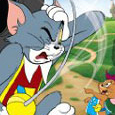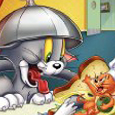Metro-Goldwyn-Mayer (1943-1951), Warner Home Video (June 16, 2009), Single Disc, 102 minutes, 1.33:1 aspect ratio, Dolby Digital 1.0 Mono, Not Rated, Retail $14.98
Storyboard:
Continuing with their latest strategy of releasing classic animation in one-disc sets, Warner’s latest targets are Tom and Jerry. After trying their luck with three “Spotlight” collection releases of the classic shorts (all three with some flaws, editing among them), and a recent Chuck Jones release for the duo, Warner has finally reverted back to the original release format – Greatest Chases, first used in their 2000 release Tom and Jerry’s Greatest Chases. The original release featured fourteen shorts totaling 101 minutes of classic chases with the cat and mouse duo. Sure, one of those cartoons (The Little Orphan) was edited. However, back in 2000, there were very few classic Tom and Jerry releases and we had not yet seen any major collector’s editions of classic shorts. The new set, released nine years after the first volume, follows it up with a new collection of fourteen shorts totaling 102 minutes. While being mass-marketed for the more casual fan of the shorts, the DVDs provide an interesting alternative for those who are still unwilling to shell out more for the flawed spotlight collections.
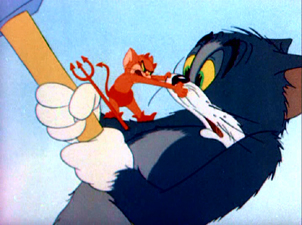
The Sweatbox Review:
Tom and Jerry have always been different from other chase-based cartoons. Looney Tunes perfected the genre with the comical and witty pairings of Bugs Bunny vs. Elmer Fudd and Yosemite Sam, Road Runner vs. Wile E. Coyote, and Sylvester vs. Tweeti and Speedy Gonzalez. However, Tom and Jerry always stood apart from the crowd due to the personalities of the two main characters. In reality, unlike the antagonists in the Looney Tunes canon (with the exception of the relatively more recent cat-and-mouse duo of Sylvester and Speedy), Tom is actually doing a service to the community – killing/chasing mice. In fact, when Tom is chastised by humans for his behavior in the cartoons, it frequently is for being loud or for making a mess. Jerry, on the other hand, is much different from other chased characters. He is not as oblivious as Road Runner, or as cunning as Bugs Bunny. In fact, I would argue that in most cartoons we actually want Tom to catch Jerry, if only because he makes life increasingly difficult for the domesticated cat. Of course, Tom is no saint and I would say that he usually gets what he deserves. Jerry, on the other hand, can also be rude, he loves to tease Tom, and frequently takes advantage of Tom’s situation with his owners or his relationship with Spike, the dog that serves as a bodyguard for Jerry in many cartoons. At the same time, the mouse is actually very likeable and somehow we end up rooting for him as well. Jerry is somewhere between Woody Woodpecker and Bugs Bunny, in the sense that he’s not as annoying as Woody, but definitely not as smart as Bugs. Together, the two make a very charismatic and dynamic duo.
Most Tom and Jerry cartoons are very basic and easy to understand. It is a testament to Hanna-Barbera and the rest of the team at the MGM Cartoon Studio that there is plenty of variety in the chases. It’s not about what Jerry does to Tom or vice-versa, but rather about the specific situation Tom faces in each short. This slightly varies from cartoon to cartoon to make it less repetitive to fans. In one cartoon, Tom may be acting as a pet to a young girl and in the next he is a house cat being warned to keep quiet or face the consequences. Sometimes the short begins with Tom being merciless to Jerry and doing his best to torture the poor mouse. Once Jerry realizes what is at stake for Tom, he strikes in revenge, capitalizing on Tom’s faults (his fear of being punished, his eagerness to catch mice, and his inability to think things through). At some point, the balance of power shifts one way or the other, usually by the addition of an external force. The rest of the short usually depicts Tom getting dangerously close to being caught by Spike or by his owner. Eventually, Tom gets fed up with everything and gives up being cautious, causing a mess in the process and leading to the inevitable ending (many times involving explosions). Sometimes (and this was also true in some Bugs Bunny cartoons), Jerry shares in the punishment and realizes that he must also face the consequences. Some of the best endings are when the balance of power is restored and both must revert to their game of cat and mouse.

The fourteen cartoons in this set feature a variety of situations and most are from the mid-forties. Two of the shorts (Mouse Trouble and Quiet Please!) are Academy Award winners (for 1944 and 1945 respectively) and another is an academy award nominee (Sufferin’ Cats – 1950). However, with the quality and variety in this set, I wouldn’t be surprised to learn many of these were on the shortlist for their perspective years. Most of these shorts feature excellent comic timing and ingenious situations. There are also a lot of firsts and unique situations in these cartoons. We have violent cartoons leading to Tom’s death, cartoons where Tom triumphs in the end, others where the talks, and we also have first-time appearances from many of the supporting cast of characters (Spike, Tyke, Topsy, Butch, Meathead, Muscles). The best of the bunch include unexpected endings such as in Mouse Trouble, The Bodyguard, Baby Puss, Million Dollar Cat, and Heavenly Puss.
Mouse Trouble (1944) – Tom orders a book that teaches him how to catch mice, which he follows chapter by chapter. Needless to say, Jerry is much too clever to fall into his traps. It is a clever series of plans that work out disastrously for Tom.
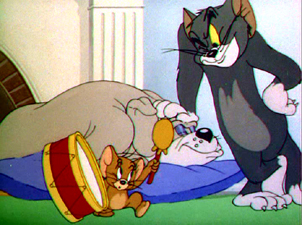
The Bodyguard (1944) – Jerry saves Spike from the dogcatcher and Spike agrees to protect him against Tom. For the remainder of the cartoon, Tom tries to figure out a way to catch Jerry without him whistling for Spike’s help. While this is his second appearance in a Tom and Jerry cartoon, this marks the first time we hear Spike speak.
Quiet Please! (1945) – In this short, Spike and Tom are both pets in the same home. The story begins with Spike warning Tom that he must remain quiet while he is trying to take a nap. Jerry catches on to the danger and sets out to create as much noise as he can to get Tom into trouble. This was the second straight Oscar win for Tom and Jerry and cemented their status as cartoon mainstays.
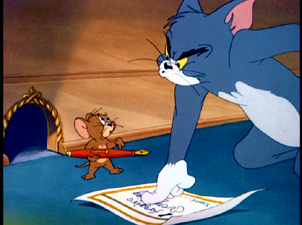
Cat Fishin’ (1947)– Tom goes to a park to fish at a lake and Spike is the guard dog protecting the lake from fishermen. Jerry is bait. The story develops as Tom tries to capture a powerful fish using Jerry as a lure. Eventually, Jerry and the fish both irritate Tom while Spike tries to capture him.
Slicked-Up Pup (1951) – Spike has just finished giving his son a bath when Tom almost gets him dirty while chasing after Jerry. He then forces Tom to puppysit Tyke until he returns. Jerry, seizing on the opportunity, does everything he can to get the poor pup dirty while making sure Tom gets the blame.
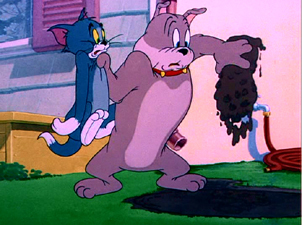
Baby Puss (1943) – Tom is dressed up like a baby by a young girl and feels embarrassed when Jerry and the other neighborhood cats start to tease him. This was the first appearance of his young white owner, and of his two cat friends Topsy and Butch.
Sufferin’ Cats (1943) – In a typical cartoon, Jerry is being chased after by Tom when he encounters another cat and decides to let the two of them battle it out while he tries to get away. This is the first appearance of Meathead in a cartoon.
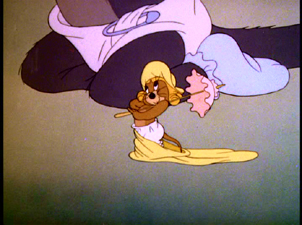
Jerry’s Cousin (1951) – Jerry invites his strong city cousin Muscles to help him with Tom. Muscles returns to teach Tom a lesson. This short was nominated for the 1950 Academy Award.
Million Dollar Cat (1944) – Tom gets an inheritance but the catch is that he must not harm a living soul (including a mouse). The wealthy cat then moves into a new residence, but Jerry just follows along knowing that he can’t be touched. Jerry then drives Tom crazy until he is driven to insanity.
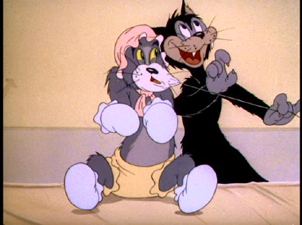
Invisible Mouse (1947) – Jerry finds invisible ink while running away from Tom and the chase is intensified. Tom must resort to deduction and his smarts to capture Jerry.
Flirty Birdy (1945) – In a story similar to Sufferin’Cats, Jerry is being followed by Tom when they run into a hawk. Tom must then figure out how to get Jerry away from the hawk, resorting to good, old-fashioned cross-dressing to seduce the bird. I think it’s important to note that an often-edited scene where Tom resembles a cigar store Indian is intact for this release.
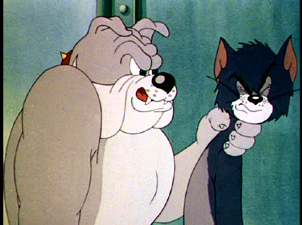
Jerry and the Goldfish (1951) – Tom is trying out new recipes, but his latest requires a fish. Tom then decides to use the family pet goldfish and Jerry intervenes.
Cue Ball Cat (1950) – Tom plays billiards and ends up infuriating Jerry. This is a basic cartoon with Jerry trying to infuriate Tom while avoiding getting hurt by the cue balls.
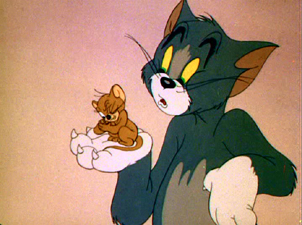
Heavenly Puss (1949) – In the beginning of the short, Tom suffers an accident, dies and ascends to heaven’s gate. However, before entering heaven, he has one hour to obtain a pardon from Jerry for his sins or suffer the consequences.
Is This Thing Loaded?
In short, there are no major special features included in this release. The only extras are trailers for Tiny Toon Adventures, Freakazoid!, The Jetsons, Peanuts: Snoopy’s Reunion, Sesame Street Presents: Follow That Bird, and Tom and Jerry Tales.

Case Study:
Warner Bros. has released this DVD in a standard, black keepcase. The cover features Tom (with his head through a drum), Jerry (holding a drum stick), and Spike (running around in the background). The art is mostly according to the well-known modern character models for each character. The back of the case features Jerry riding on Spike who is chasing after Tom. I think that the cover art does a good job as portraying this as a chase-filled release by having the three animals chasing one another. My one problem with the case is that it advertises a false soundtrack. The back cover mentions a Thai track, but this is not actually included in the disc (see Scratch Tracks for more comments).
Ink And Paint:
All cartoons included in this release have been included in their original 1.33:1 aspect ratio. None of these shorts were originally in cinemascope, so Warner did not have to deal with incorrect aspect ratios in this release. The quality of the print varies from short to short. Some shorts look relatively clean given their age with minimal scratches and dust particles; however some of the other ones have considerably more grain. All-in-all, however, none of this is too distracting and did not prevent me from enjoying the collection. Collectors should note that all 14 cartoons featured in this set have already been released and are included in the 2004 release of Tom and Jerry: Spotlight Collection, Vol. 1.
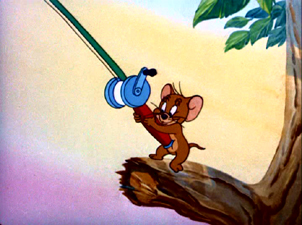
Scratch Tracks:
Warner Bros. has gotten sloppy. The studio has released this set with a basic Dolby Digital 2.0 English track and a Dolby Digital 1.0 Mono Portuguese track. I say sloppy, however, because this is the third consecutive Warner release I have noticed has an advertised track not actually included. There is supposed to be a Thai soundtrack, but this is not found in the actual release. The English soundtrack itself is fairly inconsistent throughout the release. Volume will vary greatly from one short to the next, affecting the overall quality of this release. For example, Baby Puss opens much louder than the previous Sufferin’ Cats causing the viewer to adjust volume at the beginning of each short. While this is not a major problem, given the low standards of quality this set is aiming for (I would have more of an issue if this was a Spotlight Collection release), it could have been easily fixed in production. English, French, Portuguese, and Thai subtitles are also included.
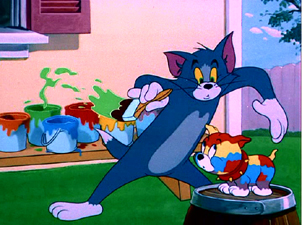
Final Cut:
Whether you like it or not, this one-disc, best-of format is here to stay. Warner will continue releasing their classic television and theatrical shorts in single-disc formats for more casual fans. However, with Spotlight Collection, Vol. 1 priced at a lower cost than this release in most online retailers, I’m not sure this is worth the price for half as many cartoons. However, Warner will continue releasing these cartoons in this manner. The third Greatest Chases volume is already expected for October. It just depends on the reason you are buying this disc. This disc is more recommended for only casual fans of Tom and Jerry and for parents who do not want their children playing with their collector’s Spotlight DVDs. For everyone else, I would recommend sticking with the Spotlight releases.
 | ||
 |







